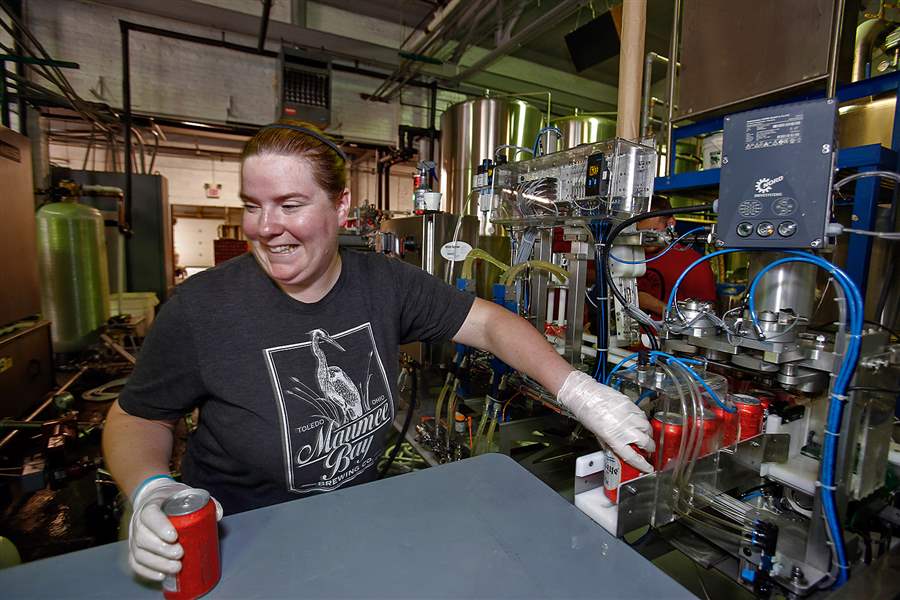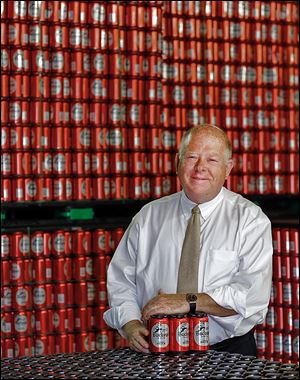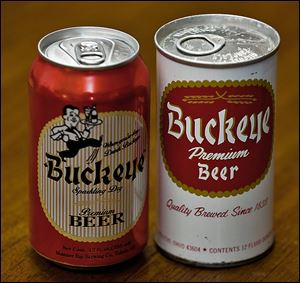
Beloved local brew hopping back into canned incarnation
Maumee Bay Brewing Co. processing Buckeye Beer
10/12/2013
Shannon Mohr moves canned Buckeye Beer to be pasteurized at Maumee Bay Brewing Co. The brewery started bottling some of its craft beers earlier this year, and the portable canning line became operational at the beginning of the month.
THE BLADE/JEREMY WADSWORTH
Buy This Image

Shannon Mohr moves canned Buckeye Beer to be pasteurized at Maumee Bay Brewing Co. The brewery started bottling some of its craft beers earlier this year, and the portable canning line became operational at the beginning of the month.
Buckeye Beer is readily available in bottles, but beer enthusiasts who wanted to find the stuff in cans were stuck with searching dusty basement shelves or scrolling through online auction listings.

Neal Kovacik, general manager of Maumee Bay Brewing Co., says his microbrewery is in the first wave of a handful of small Ohio breweries getting into canning their craft beers.
Imbibing from those cans would be ill-advised as the canning line last ran in the early 1970s.
That’s all changing.
Maumee Bay Brewing Co., which makes the modern reincarnation of Toledo’s own Buckeye Beer, recently processed the first cans of Buckeye in 41 years.
The move brings with it some nostalgia, but company officials say it’s much more about pushing the brand forward.
“We see more sales potential, and we hopefully can get a whole different segment of the market that we haven’t gotten before,” said Neal Kovacik, general manager of Maumee Bay Brewing Co.
Traditionally, microbreweries have released their products in bottles, and that’s still overwhelmingly the case.
Leading glass bottle maker Owens-Illinois Inc. says 64 percent of the craft beer sold in the United States is packaged in glass, versus 6 to 7 percent in cans. The rest is sold on draft.
The craft beer market is an important one. Though the overall U.S. beer market is flat this year, O-I said craft beers have grown 17 percent. The Perrysburg company says it supplies bottles for more than half the market, including selling bottles to Maumee Bay.

The new can, left, has been updated from the container that the beer came in 41 years ago.
And while O-I argues the bottle is best, it does acknowledge the can is gaining some market share.
Many people in the beer industry say canning is the hot thing right now, and it is likely to keep growing.
“This seems to be the direction a lot of the business is going,” Mr. Kovacik said. “It’s very well accepted by the craft-beer drinking public. It’s the best way to package beer, and people are excited about it.”
Cans of Buckeye Beer will be available soon in any retail store where bottles of Buckeye are currently sold.
Maumee Bay is in the first wave of a handful of small Ohio breweries getting into canning, but nationally hundreds of breweries are releasing their products in cans.
“Cans seem to be sort of the cool thing right now,” said Russ Phillips, the owner of CraftCans.com.
One reason is they fit the lifestyle of many craft beer drinkers better than bottles — camping, outdoor concerts, boating, spending the day poolside. People who follow the industry say cans are also slowly overcoming a reputation for only carrying cheap swill and ultra mainstream beers.
The Web site started as a hobby for Mr. Phillips, but the site has grown into a recognized authority on canned craft beers. The database tracks canned craft beers from 337 breweries nationwide.
Some may wonder what the big deal is. Beer is beer, whether it comes in glass, aluminum, or plastic. You pop open the container and drink it.

Maumee Bay Brewing Co. begins putting Toledo’s Buckeye Beer into cans, which are again becoming popular.
But many in the industry say canning is actually the best choice for preserving a beer’s fresh taste.
“Canning, when it's done right, it can really lock in the flavor of a beer and keep out more oxygen than bottling. It’s actually better for the beer,” Mr. Phillips said.
It may also be better for the bottom line. Mr. Kovacik said other microbreweries that have put their beers in cans have enjoyed significant increase in sales. Maumee Bay expects the same, anticipating as much as a 30 percent sales boost for Buckeye.
The brewery also hopes to release some of its other beers in cans after it buys its own canning system.
That’s not a cheap undertaking. Mr. Kovacik said Maumee Bay’s system is expected to cost about $100,000. That’s a sizeable investment and one that’s hard to justify for many small breweries.
But brewers still want to can.
That has given rise to a new niche industry for mobile canning units, such as Buckeye Canning Co. in Amherst, Ohio, the company that did Maumee Bay’s first run earlier this month.
Co-owner B.J. Solomon has a whole list of reasons why cans are a good business decision, but he hasn’t seemed to need them.
“When we’ve gone into the breweries, we haven’t had to sell the can at all. We’re selling ourselves and our business, what we’re doing. But we haven’t had to say ‘this is why you should do the can,’ ” he said.
Great Black Swamp Brewing Co., another Toledo microbrewery, has looked into canning but isn't ready to do anything yet. The four-year-old company has been focused on expanding its footprint, and it soon will start selling in Cleveland — Great Black Swamp’s first market outside of northwest Ohio.
Still, owner Paul Traver said cans are “definitely the direction the industry is going.”
“Your messaging can be a little more bold than it can with a bottle,” Mr. Traver said.
Those bold designs are also rejuvenating an old hobby.
“This isn’t a reason to do it,” Mr. Kovacik said of canning Buckeye, “but 35,000 beer can collectors in the United States are clamoring for one of these. It creates a lot of interest in the brand.”
Beer-can collecting peaked in the 1970s and 1980s, but as fewer variations were available, the hobby faltered.
“I think it was on its last leg before the craft canning broke out,” Mr. Phillips said.
Now some of those collectors are pulling old boxes out of the attic and putting their cans back on display, said John Huff, president of the 50-member Buckeye Chapter of the Brewery Collectibles Club of America.
“It’s starting to come back right now, especially with the craft beers. People are realizing it’s a neat thing to collect again,” said Mr. Huff, who lives in Temperance.
The people in Mr. Huff’s chapter of the national organization don’t just collect items related to Buckeye Beer, but he said they’re eager to get the new cans. He also figures to take cases to some of his friends in the hobby who live outside Buckeye’s distribution area.
Mr. Phillips, who ended up getting a book deal out of his Web site, also looks forward to getting his hands on the new Buckeye cans.
“I’m trying to grab a couple to try to get them in the next book and get them on the site as well,” Mr. Phillips said.
Contact Tyrel Linkhorn at tlinkhorn@theblade.com or 419-724-6134.